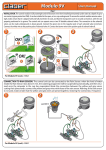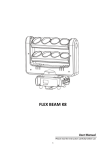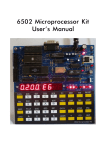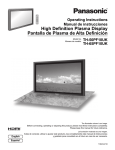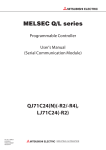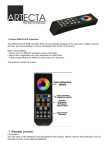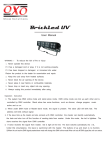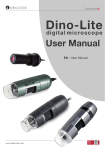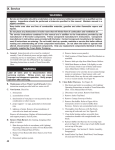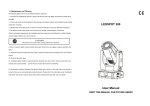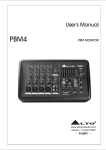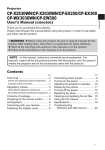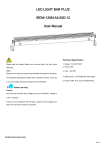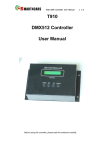Download Example Programs for 6502 Microprocessor Kit
Transcript
Example Programs for 6502 Microprocessor Kit 0001 0000 0002 0000 GPIO1 0003 0000 0004 0000 0005 0200 0006 0200 0007 0200 A5 00 0008 0202 8D 00 80 0009 0205 00 0010 0206 0011 0206 0012 0206 tasm: Number of errors = 0 .EQU $8000 .ORG $200 LDA $0 STA $GPIO1 BRK .END Build Your Own 6502 Microprocessor kit www.kmitl.ac.th/~kswichit/6502/6502.html Preface The example programs for 6502 Microprocessor kit demonstrate how to enter the computer program in hex code and how to use the onboard input/output devices, e.g. GPIO1 LED, key switch, speaker, 7-segment display, and 10ms system tick generator. Each program is simple and short. The instruction hex codes are provided. Students can enter the hex code to memory and test it directly. No need others tools. The monitor program provides single step running with user registers and zero page memory displaying. Students can check the result of CPU operation with these registers easily. The program can be modified at the 8-bit constants, or even with the instruction itself, student will learn the result after program modifications. For the hardware programming, e.g. key switch, speaker, 7segment display and interrupt please study the hardware schematic in user manual. Wichit Sirichote Contents Program1: Binary number counting....................4 Program2: Bit shifting.............................................7 Program3: LOAD and STORE...............................8 Program4: 8-bit Addition.......................................9 Program5: Conditional branch instruction.......12 Program6: Reading switch status......................14 Program7: Producing tone 800Hz.....................16 Program8: Simple MORSE code keyer.............18 Program9: Seven segment display....................20 Program10: Testing IRQ with 10ms Tick..........24 Program1: Binary number counting This program uses memory location 0 in zero page as the 8-bit variable. We will see the 8-bit binary number counting by writing the contents of memory location 0 to the GPIO1 LED at location $8000. Logic 1 will make LED ON and logic 0 for LED OFF. We can enter the instruction hex code to the memory started from location $200 to the last byte at location $20D. To test the program, press key RESET, PC then press STEP and REP together. Did you see the 8-bit binary number counting? Line 0001 0002 0003 0004 0005 0006 Addr hex code 0000 0000 0000 0000 0200 0200 Label Instruction GPIO1 .EQU $8000 .ORG 200H 5 0007 0200 A9 00 0008 0202 85 00 0009 0204 0010 0204 A5 00 LOOP 0011 0206 8D 00 80 0012 0209 E6 00 0013 020B 0014 020B 4C 04 02 0015 020E 0016 020E tasm: Number of errors = 0 LDA #0 STA $0 LDA $0 STA GPIO1 INC $0 JMP LOOP .END The 6502 kit display and keypad use hex number. Since each hex digit represents 4-bit binary number or one nibble. It will make us more easy to enter the program using hex number. The actual code in memory is binary number. For example the hex code of instruction LDA #0 has two bytes A9 and 00. The display will show us as A9 at location 0200. The real value, however in memory will be 1010 1001. Here is the number representation for decimal, binary and hexadecimal number. Decimal 0 1 2 3 4 5 6 7 8 4-bit Binary 0000 0001 0010 0011 0100 0101 0110 0111 1000 Hex 0 1 2 3 4 5 6 7 8 9 10 11 12 13 14 15 1001 1010 1011 1100 1101 1110 1111 9 A B C D E F For example the instruction hex code of LDA #0 is A9 and 00. We can write the first byte in 8-bit binary as 1010 1001 and the second byte as 0000 0000. Note Writing hex number in the Assembly Program can be done with $ or H symbol. We see that the assembler directive .org 200H will be the same as .org $200. The sharp symbol # indicating the number is 8-bit data to be loaded. If no # symbol, the 8-bit data will be memory location. For example, LDA #0 ; load accumulator with data 0 LDA $0 ; load accumulator with memory location 0 in zero page. 7 Program2: Bit shifting This program looks similar to Program1, but we use instruction that shifts the bit, ASL $0, instead of INC $0. Enter the hex code, then test it with STEP & REP key. What is the result on the GPIO1 LED? 0001 0000 0002 0000 GPIO1 0003 0000 0004 0000 0005 0200 0006 0200 0007 0200 A9 01 0008 0202 85 00 0009 0204 0010 0204 A5 00 LOOP 0011 0206 8D 00 80 0012 0209 06 00 0013 020B 0014 020B 4C 04 02 0015 020E 0016 020E tasm: Number of errors = 0 .EQU $8000 .ORG 200H LDA #1 STA $0 LDA $0 STA GPIO1 ASL $0 JMP LOOP .END We see that the GPIO1 LED is very useful for reading the 8-bit data. We can see the result of internal operation by using the Accumulator register as the data carrier. The instruction STA GPIO1, having hex code as 8D 00 80 will write the contents of accumulator register to GPIO1 LED. 8 Program3: LOAD and STORE Another method to test program running is to use BRK instruction. We will test the code with key GO. Our program has only three instructions, LDA $0, STA $GPIO1 and BRK. BRK instruction will make the CPU to jump back to monitor program, saving the CPU registers to user registers. We can keep the results in user registers for program checking. This program will load the accumulator with contents at memory location $0 then write it to GPIO1 LED and ended with BRK instruction. 0001 0000 0002 0000 GPIO1 0003 0000 0004 0000 0005 0200 0006 0200 0007 0200 A5 00 0008 0202 8D 00 80 0009 0205 00 0010 0206 0011 0206 0012 0206 tasm: Number of errors = 0 .EQU $8000 .ORG 200H LDA $0 STA $GPIO1 BRK .END Enter the hex code, press RESET, PC and GO. What is result on the GPIO1 LED? If we change the byte at location $201 from 00 to 01, what is the result? 9 Program4: 8-bit Addition Let us play with 8-bit binary addition. Suppose we want to add two 8-bit binary numbers as shown below. Number 1 Number 2 Result is 0101 1011+ 0101 1010 __________ 5B+ 5A _____ Remember 1+1= 10 Try with hand compute, write the result for both binary and hex. Now let us check the result from 6502 computing. 0001 0000 0002 0000 GPIO1 .EQU $8000 0003 0000 0004 0000 0005 0200 .ORG 200H 0006 0200 0007 0200 18 CLC 0008 0201 A9 5B LDA #%01011011 0009 0203 69 5A ADC #%01011010 0010 0205 8D 00 80 STA $GPIO1 0011 0208 00 BRK 0012 0209 0013 0209 0014 0209 .END tasm: Number of errors = 0 The program will load number1, 5B to the accumulator. Then add it with 5B and then write the result to GPIO1 LED. Do you have got the same result? 10 Since the ADC instruction will add two numbers with carry flag, so for the rightmost digit, there is no carry flag. We then clear it beforehand with instruction CLC, CLear Carry. You can try replace the first byte from 18 (CLC) to 38, SEC instruction that sets carry flag. And test the program again. What is the result? Carry flag will be used for multi ple bytes addition the same as we add multi ple digits of decimal number. We can modify above program for testing with logical instructions as well. By replacing ADC instruction with, Logical OR with instruction ORA #n Logical AND, AND #n Exclusive OR, EOR #n For example if we want to find the result of logical AND between $4A and $33 the program will be, 0005 0200 .ORG 200H 0006 0200 0007 0200 18 CLC 0008 0201 A9 4A LDA #$4A 0009 0203 29 33 AND #$33 0010 0205 8D 00 80 STA $GPIO1 0011 0208 00 BRK 0012 0209 0013 0209 0014 0209 .END tasm: Number of errors = 0 We see that at the address 0203, now the hex code is 29, the AND instruction. And the 2nd byte is 33, the 8-bit data to be ANDed with 4A. Result will show on the GPIO1 LED directly. Note Symbol % shown in the program is for binary number constant. Remember $ is for hex number. The hex code for AND #n is $29 ORA #n is $09 EOR #n is $49 Find more the 6502 hex code from http://www.obelisk.demon.co.uk/6502/reference.html Program5: Conditional branch instruction The 6502 CPU has the instructions that jump with flag condition. The example of flag is ZERO flag. The zero flag will be '1' when all bits in a given memory location or register are zero. We can use such indication for changing program flowing direction. Let us see the example of using BNE instruction. 0001 0000 0002 0000 GPIO1 0003 0000 0004 0000 0005 0200 0006 0200 0007 0200 A2 10 0008 0202 0009 0202 8E 00 80 LOOP 0010 0205 CA 0011 0206 D0 FA 0012 0208 0013 0208 8E 00 80 0014 020B 4C 0B 02 HERE 0015 020E 0016 020E tasm: Number of errors = 0 .EQU $8000 .ORG 200H LDX #$10 STX GPIO1 DEX BNE LOOP STX GPIO1 JMP HERE .END Register X is loaded with $10. Main loop is to write the X register to GPIO1 LED. DEX instruction will decrement X register by one. Zero flag will be set if the all bits in X register are zero. We can control the number of loop running by BNE instruction then. 13 BNE, Branch if Not Equal to ZERO, has two bytes hex code, i.e. D0 and FA. The second byte, FA is signed number. It is the OFFSET byte that will be used to add to the current program counter if the result is not equal to zero. Current program counter after these two bytes were read by the CPU is 208. We see from the program that the loop location is 202. Thus the OFFSET byte is 202-208=-6. Or jump backward 6 bytes. We can make -6 from +6 by using 2's complement. The computer uses 2's complement to represent the negative number. Here is +6 in 8-bit binary, 0000 0110 2's complement is 1's complement +1 This is 1's complement 1111 1001 Then +1 1111 1010 or FA, we see that the OFFSET byte FA is then -6. We can also use key REL for finding the OFFSET byte. At the display 0206 with D0, press REL key, the address 0206 will be start address. Press key + for the destination, enter 0202, the press key GO. The OFFSET byte FA will be placed at address 0207 automatically. On the hex keypad, you may count backward from key F to key A. You will get -6 is FA! We will use conditional jump instructions with relative addressing for many programs. 14 Program6: Reading switch status The kit has one bit that ties REP switch (S19). We can read the status of this switch easily by reading it then write it to GPIO1 LED. Logic '1' means switch is opened, and logic '0' means switch is closed. U13 is tri-state buffer used as the 8-bit input port. Program is repeating loop read the byte from PORT0. REP key is tied to bit 6 (PA6). We want to check status only this bit, so we remove the rest bits with instruction AND #%01000000. Also we invert it with EOR (Exclusive OR) EOR #%01000000. 0001 0002 0003 0004 0005 0006 0007 0008 0009 0010 0011 0012 0000 0000 0000 0000 0200 0200 0200 0203 0205 0207 020A 020D GPIO1 PORT0 .EQU 8000H .EQU 8001H .ORG 200H AD 29 49 8D 4C 01 80 40 40 00 80 00 02 LOOP LDA AND EOR STA JMP $PORT0 #%01000000 #%01000000 $GPIO1 LOOP 15 0013 020D 0014 020D tasm: Number of errors = 0 .END We test this program with key GO. What happen if we press key REP? Note Logical AND can be used to maskout undesired bit by logic '0'. Logical Exclusive OR can be used to invert the logic by using logic '1'. Logical OR can be used to set the desired bit to be '1' by using logic '1'. Program7: Producing tone 800Hz We can produce the tone signal 800Hz using one bit output port. A simple tone signal is square wave, ON and OFF. We will try with 800Hz. The small speaker is tied to bit 7 of PORT1. It is driven by Q1, PNP transistor. We can make this bit ON and OFF by writing bit 1 and bit 0 to this port. Each time we make such bit ON or OFF, a small delay is inserted. The example shown below, the delay will make period for ½0.5*1/800Hz. 17 0001 0000 0002 0000 GPIO1 0003 0000 PORT0 0004 0000 PORT1 0005 0000 0006 0200 0007 0200 0008 0200 A9 3F TONE 0009 0202 8D 02 80 0010 0205 20 13 02 0011 0208 A9 BF 0012 020A 8D 02 80 0013 020D 20 13 02 0014 0210 4C 00 02 0015 0213 0016 0213 A0 79 DELAY 0017 0215 88 DELAY2 0018 0216 D0 FD 0019 0218 60 0020 0219 0021 0219 tasm: Number of errors = 0 .EQU 8000H .EQU 8001H .EQU 8002H .ORG 200H LDA STA JSR LDA STA JSR JMP #%00111111 PORT1 DELAY #%10111111 PORT1 DELAY TONE LDY #$79 DEY BNE DELAY2 RTS .END For 800Hz, the half period is 625 microseconds. The delay subroutine will need to delay approx. a bit smaller than 625 microseconds. Can you change the frequency? Where is the byte to be modified? 18 Program8: Simple MORSE code keyer Let us have some fun with MORSE keyer program. We will combine Program 7 and Program 8. Program 7 enables us to read status of key REP and Program 8 produces 800Hz tone at the speaker. We will read if key REP was pressed, Tone 800Hz will be turned on. If key REP was released, Tone 800Hz will be turned off. This will make a simple MORSE code keyer. 0001 0002 0003 0004 0005 0006 0007 0008 0009 0010 0011 0012 0013 0014 0015 0016 0017 0000 0000 0000 0000 0000 0200 0200 0200 0203 0206 0208 020A 020A 020D 020D 0210 0212 GPIO1 PORT0 PORT1 .EQU 8000H .EQU 8001H .EQU 8002H .ORG 200H 20 AD 29 F0 1A 02 01 80 40 F6 MORSE 20 2B 02 AD 01 80 29 40 D0 F9 JSR LDA AND BEQ TONE PORT0 #%01000000 MORSE JSR DELAY WAIT LDA PORT0 AND #%01000000 BNE WAIT 19 0018 0214 0019 0214 20 2B 02 0020 0217 4C 00 02 0021 021A 0022 021A A9 3F TONE 0023 021C 8D 02 80 0024 021F 20 2B 02 0025 0222 A9 BF 0026 0224 8D 02 80 0027 0227 20 2B 02 0028 022A 60 0029 022B 0030 022B A0 79 DELAY 0031 022D 88 DELAY2 0032 022E D0 FD 0033 0230 60 0034 0231 0035 0231 tasm: Number of errors = 0 JSR DELAY JMP MORSE LDA STA JSR LDA STA JSR RTS #%00111111 PORT1 DELAY #%10111111 PORT1 DELAY LDY #$79 DEY BNE DELAY2 RTS .END We see that now we have two subroutines, TONE and DELAY. The TONE subroutine will be called from the main code only when REP key was pressed. Testing key status now can be done by using logical AND bit6 of the PORT0. MORSE tone is widely used between 750Hz to 900Hz. Can you modify our code that produces 800Hz for higher or lower frequency? 20 Program9: Seven segment display One of the generic device for displaying decimal number is 7segment display. We have the rightmost digit for experimenting by using jumper J2. A F G B C E D DP The segment A,B,C,D,E,F,G and DP are driven by PORT2. We see that each bit, CMOS output is capable for driving each segment of the LED. Logic '1' will make the segment ON. 21 To display a number says, 0,1,2,3,4,5,6,7,8,9, we must convert the 8-bit value into the corresponding pattern. See the table below. Number 0 1 2 3 4 5 6 7 8 9 SEGMENT CODE $BD $30 $9B $BA $36 $AE $AF $38 $BF $BE Display '0' '1' '2' '3' '4' '5' '6' '7' '8' '9' If we want to show number 0, the segment code $BD will be used instead. By writing $BD to PORT2 at location $8003 and put the jumper J2 to pin 1-2. Our segment driver using 74HC573, CMOS Latch, has no current limiting resistors. To produce the suitable brightness of the 7segment display, we use PWM (Pulse Width Modulation) method. The method is to turn ON and OFF the LED at high repetition rate. To make low brightness, turn ON period will be smaller than turn OFF period. The average DC power will then smaller and no heat dissi pation! If we use series current limiting resistors, heat will be I 2R. Let us have a look our program. 0001 0000 PORT1 .EQU 8002H 0002 0000 PORT2 .EQU 8003H 0003 0000 0004 0200 .ORG 200H 0005 0200 0006 0200 A9 BF LDA #$BF 0007 0202 8D 02 80 STA PORT1 0008 0205 0009 0205 A9 BD LOOP LDA #$BD 0010 0207 8D 03 80 STA PORT2 0011 020A 20 18 02 JSR DELAYON 0012 020D A9 00 LDA #%00000000 0013 020F 8D 03 80 STA PORT2 0014 0212 20 1E 02 JSR DELAYOFF 0015 0215 4C 05 02 JMP LOOP 0016 0218 0017 0218 A0 01 DELAYON LDY #1 0018 021A 88 DELAY2 DEY 0019 021B D0 FD BNE DELAY2 0020 021D 60 RTS 0021 021E 0022 021E A0 C8 DELAYOFF LDY #200 0023 0220 88 DELAY3 DEY 0024 0221 D0 FD BNE DELAY3 0025 0223 60 RTS 0026 0224 0027 0224 0028 0224 .END tasm: Number of errors = 0 Line 6 and 7 will prevent BREAK command. Let us focus at the main loop. We first write $BD to PORT2 and call delay for LED ON. Then turn off all bits at PORT2 and call delay for LED OFF. The ratio between Time ON and OFF can be approx. using the loop counter in register Y. We see that it is approx. 1:200 or 0.5%. Try enter the hex code and test it with key GO. Then put the jumper J2 to pin 1-2. Check the brightness of the LED. Can you make it more brighter? Can you change the number to be displayed? Before reset the board, remove J2 to pin 2-3. 24 Program10: Testing IRQ with 10ms Tick The onboard 10ms tick generator is produced by the AT89C2051 microcontroller. The 10ms tick signal is a 100Hz. We will learn how the 6502 responded with this signal. SW1 is the selector between 10ms tick or IRQ switch SW2. 25 The 6502 reset and interrupt vectors are put at the last page of 64kB memory space. 2106 2107 2108 2109 2110 2111 2112 2113 2114 EF1F EF1F EF1F EF1F FFFA FFFA FFFA 6C C8 FFFC 00 C0 FFFE 6F C8 ; VECTOR NMI,RESET AND IRQ .ORG 0FFFAH .WORD .WORD .WORD NMI 0C000H IRQ ; NMI ; RESET ; IRQ The monitor program put the vector address for IRQ at location $C86F. 1923 1924 C86C 6C FA 00 C86F 6C FE 00 NMI IRQ JMP JMP ($FA) ($FE) At the location $C86F, we put JUMP indirect using RAM vector at location $00FE for low byte and $00FF for high byte. With this method, we can then test the IRQ process by placing the IRQ vector in RAM. 0001 0002 0003 0004 0005 0006 0007 0008 0009 0000 0000 0000 0000 0000 0000 0000 0030 0030 GPIO1 PORT0 PORT1 PORT2 .EQU .EQU .EQU .EQU 8000H 8001H 8002H 8003H .ORG $30 0010 0011 0012 0013 0014 0015 0016 0017 0018 0019 0020 0021 0022 0023 0024 0025 0026 0027 0028 0029 0030 0031 0032 0033 0034 0035 0036 0037 0038 0039 0040 0041 0042 0043 0044 0045 0046 0030 0031 0032 0032 00FE 00FE 0100 0200 0200 0200 0202 0204 0206 0208 0208 0209 020C 020C 020C 020C 020C 020D 020D 020E 0210 0212 0214 0216 0218 021A 021A 021B 021D 021F 0221 0221 0223 SEC100 SEC .BLOCK 1 .BLOCK 1 .ORG $FE .WORD SERVICE_IRQ 0C 02 .ORG 200H A9 85 A9 85 0C FE 02 FF 58 4C 09 02 MAIN LDA #SERVICE_IRQ&$FF STA $FE LDA #2 STA $FF CLI ; ENABLE IRQ JMP $ ; jump here SERVICE_IRQ 78 SEI F8 E6 A5 C9 D0 A9 85 SED INC LDA CMP BNE LDA STA 30 30 64 10 00 30 ;DECIMAL MODE SEC100 SEC100 #100 SKIP1 #0 SEC100 18 A5 31 69 01 85 31 CLC LDA SEC ADC #1 STA SEC A5 31 8D 00 80 LDA SEC STA GPIO1 0047 0226 0048 0226 SKIP1 0049 0226 40 0050 0227 0051 0227 0052 0227 tasm: Number of errors = 0 RTI .END Main program begins with storing the service address of IRQ at location $00FE and $00FF. The service address is $020C. Then ENABLE the interrupt with instruction CLI. And jump here waiting the trigger from 10ms tick. When the CPU recognize the IRQ trigger, it will save current PC and jump to interrupt service subroutine at $020C. The service for IRQ will be entered every 10ms. The SEC100 variable will be incremented, when it is 100, it will be one second. The SEC variable will then be incremented in BCD number and wrote to the GPIO1 LED. Let us test the code with key GO and see what happen on the GPIO1 LED?





























